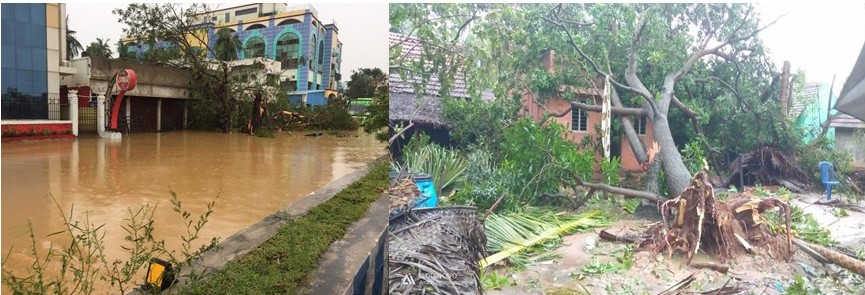GAJA Cyclone – Facts and figures
GAJA Cyclone is the 10th cyclone to affect Tamil Nadu in the past 16 years. The total number of cyclones that have affected the state between 1891 and 2002 are 54, which is the fourth highest in the country after Odisha (98), Andhra Pradesh (79) and West Bengal (69). This means that while the rate of occurrence of cyclones in the state between 1891 and 2002 was 0.49 per year, in between 2003 to 2018 the rate increased to 0.63 per year. The rate of occurrence has increased by almost 30 per cent (Down to Earth, 2018).
Cyclone Gaja has left a trail of destruction in the delta districts of Tamil Nadu claiming lives of at least 63 people. Around 250,000 people have been evacuated in 8 affected districts where wind speeds reached 120 kmph when the storm made landfall on Nov. 16. The impact of the cyclone also damaged electricity transformers and power lines, cutting off electricity in several districts. In a number of affected areas, including the Thanjavur,Tiruvarur, Pudukottai, Trichirapalli, Dindigul, Ramnad, Nagapattinam District and Karikal District of UT of Puducherry.

The damages as of 24th Nov 2018 is as follows
|
Overview of the impact GAJA Cyclone
|
|
|
Affected Districts:
|
12
|
|
No of Persons died
|
63
|
|
No of relief camps
|
556
|
|
No of persons evacuated
|
307819
|
|
Household infrastructure damage
|
|
|
No of huts completely damaged
|
278824
|
|
No of roof tiled houses damaged
|
62996
|
|
Livelihood Loss
|
|
|
No of cattle died
|
12298
|
|
No of birds died
|
92507
|
|
No of Coconut trees (350000) cultivated in
|
3100 hectare affected
|
|
Paddy field affected
|
32706 hectare
|
|
Completely damaged boats
|
1419
|
|
Partially damaged boats
|
2625
|
|
Agriculture and horticulture damage in
|
88102 hectare
|
|
Public Infrastructure damage
|
|
|
No of trees uprooted
|
1132686
|
|
No of municipalities affected by the public drinking water system
|
174
|
|
No of Town Panchayats affected by the public drinking water system
|
270
|
|
No of Village Panchayats affected by the public drinking water system
|
8522
|
|
No of electric poles damaged
|
103508
|
|
No of electricity disconnected houses
|
5321506
|
|
No of transformers damaged
|
886
|
|
No of electricity distributing sub stations damaged
|
201
|
Source : Media
The situation is much worse, it would take at least a month to restore normalcy. Most of the villages hadn’t received any relief material or help from the government – even 2 weeks after the storm hit. Instances of people blocking the roads and stopping ministers and officials from visiting places have widely been reported. Farmers’ suicides are being reported from the cyclone-hit areas, owing to the loss of crops and livelihood.
The impact created by cyclone Gaja certainly is deeper than we could imagine. The livelihoods of thousands of villagers have been destroyed. The government is still not in control of the situation. The government was merely doing coordination work, but with no local body representatives worsening the situation. The damage assessment and announced compensations for the damages are also not corresponding to the loss.

As of now, Caritas and CRS supported Rs 10,00,000 each for immediate relief activities. National and international media have not broadcasted the intensity of the devastation to the public. As it is the 5th disaster happened in this year (2018), fund mobilization has become very challenging at the State, National and International level. The Church and its institutions in Tamil Nadu, religious congregations, and the Social Service Societies have mobilized the relief materials and distributing it till date.
It will take at least 7-10 years to rebuild their livelihoods, the future of the affected families, the education of the children, the marriage of the adolescent girls, the day to day life of the marginalized specially Dalits, small and marginal farmers, disabled, widows, are very challenging which needs multi-stakeholder interventions, long-term support to restore the people who are in irreparable loss and pain. It is the time that the Church should be proactive like a good Samarian to address the cry of the people.
Encl: Key findings and recommendations of the Inter Agency Group (IAG) Tamil Nadu